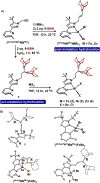A Bidentate Ligand Featuring Ditopic Lewis Acids in the Second Sphere for Selective Substrate Capture and Activation
- PMID: 36720708
- PMCID: PMC10023486
- DOI: 10.1002/anie.202218907
A Bidentate Ligand Featuring Ditopic Lewis Acids in the Second Sphere for Selective Substrate Capture and Activation
Abstract
We present a ligand platform featuring appended ditopic Lewis acids to facilitate capture/activation of diatomic substrates. We show that incorporation of two 9-borabicyclo[3.3.1]nonane (9-BBN) units on a single carbon tethered to a pyridine pyrazole scaffold maintains a set of unquenched nitrogen donors available to coordinate FeII , ZnII , and NiII . Using hydride ion affinity and competition experiments, we establish an additive effect for ditopic secondary sphere boranes, compared to the monotopic analogue. These effects are exploited to achieve high selectivity for binding NO2 - in the presence of competitive anions such as F- and NO3 - . Finally, we demonstrate hydrazine capture within the second-sphere of metal complexes, followed by unique activation pathways to generate hydrazido and diazene ligands on Zn and Fe, respectively.
Keywords: Chemoselective Anion Binding; Ditopic Boranes; Hydrazine Functionalization; Lewis Acids; Secondary Coordination Sphere.
© 2023 The Authors. Angewandte Chemie International Edition published by Wiley-VCH GmbH.
Figures





Similar articles
-
Appended Lewis Acids Enable Dioxygen Reactivity and Catalytic Oxidations with Ni(II).J Am Chem Soc. 2024 May 8;146(18):12375-12385. doi: 10.1021/jacs.3c12399. Epub 2024 Apr 25. J Am Chem Soc. 2024. PMID: 38661576 Free PMC article.
-
Hydrazine Capture and N-N Bond Cleavage at Iron Enabled by Flexible Appended Lewis Acids.J Am Chem Soc. 2017 Dec 20;139(50):18194-18197. doi: 10.1021/jacs.7b11465. Epub 2017 Dec 11. J Am Chem Soc. 2017. PMID: 29227655 Free PMC article.
-
A Borane Lewis Acid in the Secondary Coordination Sphere of a Ni(II) Imido Imparts Distinct C-H Activation Selectivity.J Am Chem Soc. 2022 Aug 31;144(34):15793-15802. doi: 10.1021/jacs.2c06662. Epub 2022 Aug 16. J Am Chem Soc. 2022. PMID: 35973127 Free PMC article.
-
Expanding the Rare-Earth Metal BINOLate Catalytic Multitool beyond Enantioselective Organic Synthesis.Acc Chem Res. 2021 Jun 1;54(11):2637-2648. doi: 10.1021/acs.accounts.1c00148. Epub 2021 May 20. Acc Chem Res. 2021. PMID: 34014657 Review.
-
Transition Metal Catalysis Controlled by Hydrogen Bonding in the Second Coordination Sphere.Chem Rev. 2022 Jul 27;122(14):12308-12369. doi: 10.1021/acs.chemrev.1c00862. Epub 2022 May 20. Chem Rev. 2022. PMID: 35593647 Free PMC article. Review.
Cited by
-
Gem-Diboronic Acids: A Motif for Anion Recognition in Competitive Media.Angew Chem Int Ed Engl. 2025 May;64(19):e202502582. doi: 10.1002/anie.202502582. Epub 2025 Mar 18. Angew Chem Int Ed Engl. 2025. PMID: 40051088 Free PMC article.
-
Appended Lewis Acids Enable Dioxygen Reactivity and Catalytic Oxidations with Ni(II).J Am Chem Soc. 2024 May 8;146(18):12375-12385. doi: 10.1021/jacs.3c12399. Epub 2024 Apr 25. J Am Chem Soc. 2024. PMID: 38661576 Free PMC article.
-
Mechanistic Studies of Alkyl Chloride Acetoxylation by Pt-Sb Complexes.Organometallics. 2025 Feb 20;44(5):617-627. doi: 10.1021/acs.organomet.4c00399. eCollection 2025 Mar 10. Organometallics. 2025. PMID: 40083949 Free PMC article.
-
Ligand Postsynthetic Functionalization with Fluorinated Boranes and Implications in Hydrogenation Catalysis.ACS Catal. 2023 Nov 30;13(24):16055-16066. doi: 10.1021/acscatal.3c02764. eCollection 2023 Dec 15. ACS Catal. 2023. PMID: 38344669 Free PMC article.
References
-
- a) Borovik AS, Acc. Chem. Res 2005, 38, 54–61; - PubMed
- b) Spatzal T, Perez KA, Einsle O, Howard JB, Rees DC, Science 2014, 345, 1620–1623; - PMC - PubMed
- c) Sippel D, Rohde M, Netzer J, Trncik C, Gies J, Grunau K, Djurdjevic I, Decamps L, Andrade SLA, Einsle O, Science 2018, 359, 1484–1489; - PubMed
- d) Van Stappen C, Deng Y, Liu Y, Heidari H, Wang J-X, Zhou Y, Ledray AP, Lu Y, Chem. Rev 2022, 122, 11974–12045; - PMC - PubMed
- e) Stripp ST, Duffus BR, Fourmond V, Léger C, Leimkühler S, Hirota S, Hu Y, Jasniewski A, Ogata H, Ribbe MW, Chem. Rev 2022, 122, 11900–11973. - PMC - PubMed
-
- a) Dos Santos PC, Igarashi RY, Lee H-I, Hoffman BM, Seefeldt LC, Dean DR, Acc. Chem. Res 2005, 38, 208–214; - PubMed
- b) Zhang X, Houk KN, Acc. Chem. Res 2005, 38, 379–385; - PubMed
- c) Prejanò M, Medina FE, Ramos MJ, Russo N, Fernandes PA, Marino T, ACS Catal 2020, 10, 2872–2881; - PMC - PubMed
- d) Warshel A, Sharma PK, Kato M, Xiang Y, Liu H, Olsson MHM, Chem. Rev 2006, 106, 3210–3235. - PubMed
-
- Drover MW, Chem. Soc. Rev 2022, 51, 1861–1880. - PubMed
-
- Miller AJM, Labinger JA, Bercaw JE, J. Am. Chem. Soc 2008, 130, 11874–11875. - PubMed
Grants and funding
LinkOut - more resources
Full Text Sources

